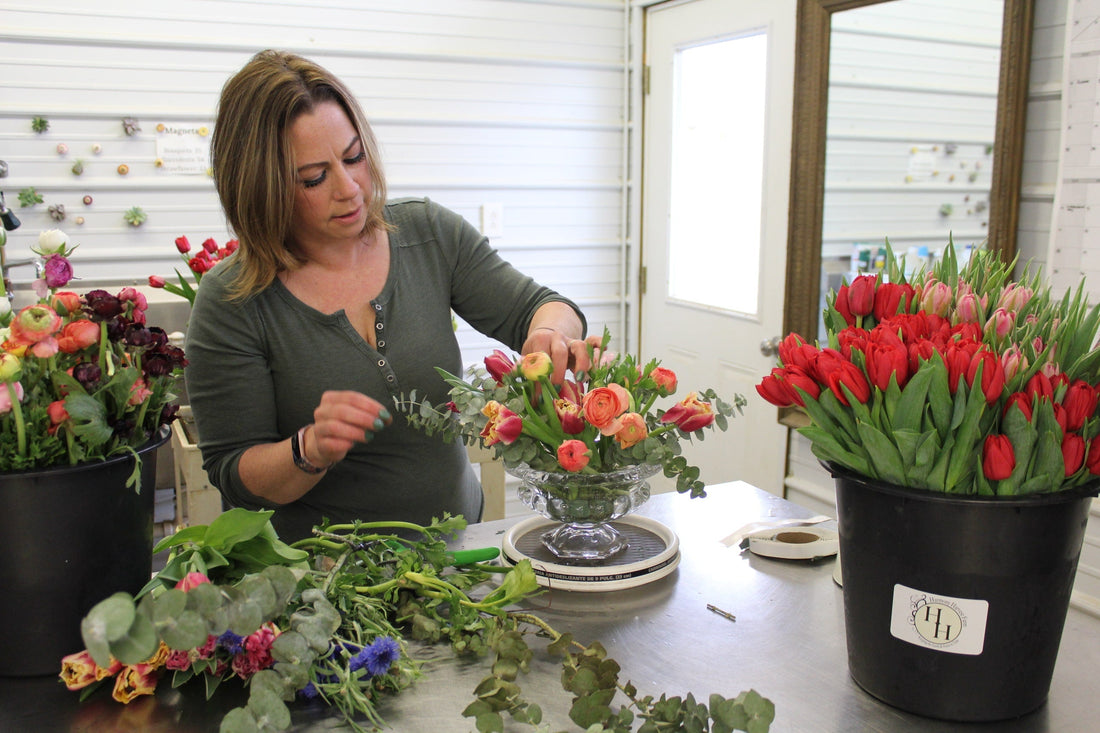
The Hidden Environmental Costs of Flowers — And How to Be a More Sustainable Floral Designer
Share
Fresh flowers bring joy, beauty, and life into our homes and events. But behind the blooms lies a surprising truth: the floral industry has a serious environmental footprint.
From chemical-laden imports to landfill-clogging waste, floral design—especially at scale—isn’t always as natural as it looks.
The good news? Sustainability and floral beauty can go hand in hand. With a few intentional shifts, we can design in a way that honors both nature and creativity.
Here’s a look at the real impact of cut flowers—and how to design more sustainably.
🌍 The Environmental Impact of the Floral Industry
✈️ 1. Global Supply Chains and Carbon Emissions
About 80% of cut flowers sold in the U.S. are imported, often from South America, Africa, or Europe. That means:
- Long-distance flights (with a large carbon footprint)
- Refrigerated transport and storage
- Fast turnaround expectations that lead to overproduction and waste
🧪 2. Pesticides and Water Usage
Many imported blooms are grown in countries with fewer environmental regulations. This can mean:
- Heavy pesticide and chemical use (some banned in the U.S.)
- High water consumption in drought-prone regions
- Worker health risks and environmental runoff
🧱 3. Single-Use Floral Foam
Floral foam is a staple of conventional flower arranging, but it’s toxic and unsustainable.
- Made from plastic and formaldehyde-based chemicals
- Breaks down into microplastics that pollute soil and waterways
- Can’t be composted or recycled—used once, then tossed
🗑️ 4. Packaging Waste and Short Shelf Life
Flowers are often wrapped in plastic sleeves, rubber bands, cardboard, and synthetic ties—all destined for the trash.
And with such a short lifespan, a huge percentage of flowers end up discarded before they’re even sold.
🌿 How to Be a More Sustainable Floral Designer
Sustainability isn’t all-or-nothing. Every small change makes a difference. Here are ways you can design more ethically and reduce your environmental impact—whether you’re a florist, event planner, or flower enthusiast.
🌱 1. Buy Local and Seasonal
Support local flower farms whenever possible by choosing what's in season, which not only means fresher, more vibrant blooms but also reduces the environmental impact of shipping. Attending farmers markets or subscribing to a CSA flower share are great ways to stay connected to what's blooming nearby. One great option is Harmony Harvest Farm, which delivers fresh, seasonal flowers straight to your door. As a bonus, locally grown flowers often last longer and showcase more character than their imported counterparts.
♻️ 2. Ditch the Floral Foam
Swap single-use floral foam for reusable, sustainable mechanics like:
- Flower Frogs (kenzan, pin holders, hairpin frogs)
- Chicken wire or reusable armatures
- Twisted branches, stems, or moss for natural structure
🌸 3. Compost Flower Waste
Dead flowers, stems, and greenery from your arrangements can be composted to reduce waste and give back to the earth. However, it's important to avoid composting any materials that have come into contact with floral foam or synthetic dyes, as these can contaminate the compost. Once properly sorted, you can use the nutrient-rich compost in your own garden or donate it to a local farm or community garden to support sustainable growing practices.
🧺 4. Reduce Single-Use Packaging
When sourcing flowers, opt for bare or bundled blooms rather than those wrapped in plastic sleeves to reduce single-use waste. For transport, choose eco-friendly alternatives like twine, reusable buckets, or recycled paper instead of disposable packaging. To take sustainability a step further, repurpose vintage vases and vessels, giving new life to old items while adding unique character to your floral designs.
🛍️ 5. Source Thoughtfully for Events
Engaging your clients in conversations about low-waste design goals is a great way to align values and create more sustainable events. Offer foam-free installations or provide rental arrangements in reusable vessels to minimize waste and encourage circular use. You can also incorporate potted plants into your designs, giving guests a thoughtful takeaway that lives on long after the event.
🌎 Designing With Purpose
The floral industry is changing. Clients are asking more questions. Designers are seeking cleaner, greener alternatives. And a growing number of farmers, florists, and makers are rising to meet that demand with sustainable flowers, tools, and methods.
By rethinking how we source, design, and dispose, we can create beauty that doesn’t cost the planet.
Every flower has the power to tell a story—and now, it can tell a better one.
